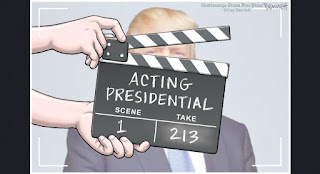Joseph Grund is a Managing Director and the Associate Manager of the Palm Beach Gardens, FL office of Ameriprise Financial Services, Inc. Joe Grund currently lives in Jupiter, FL with his wife Michelle and dog Ralph.
It has been just a few weeks since the 2016 Presidential election that resulted in a shocking Trump win. Since the election the media has endlessy tried to explain the reasons for Trump's win. They still seem as clueless as ever when trying to explain Trump' appeal.
I would recommend that the media, and all those still in shock over the results to read The article Peggy Noonan, from the Wall Street Journal, published back in February titled Trump and the Rise of the Unprotected.
She explained during the primaries what the real reasons for Trump's popularity were, and why political pundits were struggling to make sense of his popularity. If you would like to read an intelligent well written article that explains how it is that Trump won, I suggest you read this article.
Here is some of the text from her article...
We’re in a funny moment. Those who do politics for a living, some of them quite brilliant, are struggling to comprehend the central fact of the Republican primary race, while regular people have already absorbed what has happened and is happening. There are many answers and reasons, but my thoughts keep revolving around the idea of protection. It is a theme that has been something of a preoccupation in this space over the years, but I think I am seeing it now grow into an overall political dynamic throughout the West.
There are the protected and the unprotected. The protected make public policy. The unprotected live in it. The unprotected are starting to push back, powerfully. The protected are the accomplished, the secure, the successful—those who have power or access to it. They are protected from much of the roughness of the world. More to the point, they are protected from the world they have created.
They are figures in government, politics and media. They live in nice neighborhoods, safe ones. Their families function, their kids go to good schools, they’ve got some money. All of these things tend to isolate them, or provide buffers. Some of them—in Washington it is important officials in the executive branch or on the Hill; in Brussels, significant figures in the European Union—literally have their own security details.
Immigration was a big factor:
One issue obviously roiling the U.S. and Western Europe is immigration. It is the issue of the moment, a real and concrete one but also a symbolic one: It stands for all the distance between governments and their citizens.
It is of course the issue that made Donald Trump.
Britain will probably leave the European Union over it. In truth immigration is one front in that battle, but it is the most salient because of the European refugee crisis and the failure of the protected class to address it realistically and in a way that offers safety to the unprotected.
If you are an unprotected American—one with limited resources and negligible access to power—you have absorbed some lessons from the past 20 years’ experience of illegal immigration. You know the Democrats won’t protect you and the Republicans won’t help you. Both parties refused to control the border. The Republicans were afraid of being called illiberal, racist, of losing a demographic for a generation. The Democrats wanted to keep the issue alive to use it as a wedge against the Republicans and to establish themselves as owners of the Hispanic vote.
Many Americans suffered from illegal immigration—its impact on labor markets, financial costs, crime, the sense that the rule of law was collapsing. But the protected did fine—more workers at lower wages. No effect of illegal immigration was likely to hurt them personally.
It was good for the protected. But the unprotected watched and saw. They realized the protected were not looking out for them, and they inferred that they were not looking out for the country, either.
The unprotected came to think they owed the establishment—another word for the protected—nothing, no particular loyalty, no old allegiance. Mr. Trump came from that.
It is of course the issue that made Donald Trump.
Britain will probably leave the European Union over it. In truth immigration is one front in that battle, but it is the most salient because of the European refugee crisis and the failure of the protected class to address it realistically and in a way that offers safety to the unprotected.
If you are an unprotected American—one with limited resources and negligible access to power—you have absorbed some lessons from the past 20 years’ experience of illegal immigration. You know the Democrats won’t protect you and the Republicans won’t help you. Both parties refused to control the border. The Republicans were afraid of being called illiberal, racist, of losing a demographic for a generation. The Democrats wanted to keep the issue alive to use it as a wedge against the Republicans and to establish themselves as owners of the Hispanic vote.
Many Americans suffered from illegal immigration—its impact on labor markets, financial costs, crime, the sense that the rule of law was collapsing. But the protected did fine—more workers at lower wages. No effect of illegal immigration was likely to hurt them personally.
It was good for the protected. But the unprotected watched and saw. They realized the protected were not looking out for them, and they inferred that they were not looking out for the country, either.
The unprotected came to think they owed the establishment—another word for the protected—nothing, no particular loyalty, no old allegiance.
Mr. Trump came from that.
I don’t know if the protected see how serious this moment is, or their role in it.













